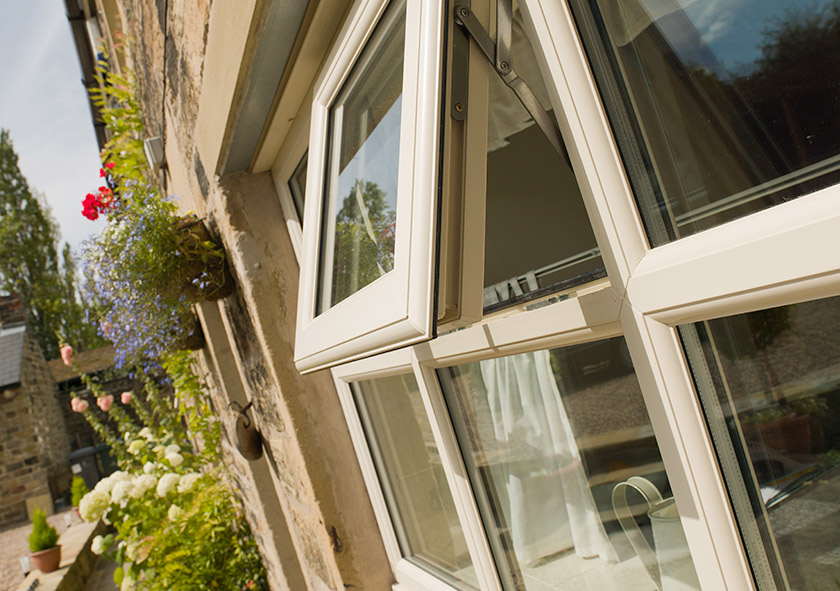
DW Windows install windows that contain glass supplied by Pilkington K. Due to new energy ratings applied to glass, there can sometimes appear to be a haze on glass and we often have customers question this. DW Windows feel it would be beneficial for customers to be able to view the reasons for this haze from the producers of the glass.
Why is my double glazing hazy?
Modern replacement windows have to be fitted with a coated glass in order to achieve adequate energy savings and reduce heat loss to meet current FENSA and Building Regulations.
The coating on the inner pane of a double glazed glass unit allows sunlight and heat to enter the building but reduces the amount that escapes by reflecting it back into the building.

Pilkington K Glass™ and the appearance of haze (Pilkington UK Technical Bulletin)
Haze is an optical phenomenon that makes the glass look like it is covered in a very fine, uniform, layer of dust when viewed from an oblique angle or viewed under strong light incident on the glass at an oblique angle. Pilkington K Glass™ can, under certain lighting conditions, display this phenomenon to a limited extent. The reason for this is that the Pilkington K Glass™ coating is not as s
mooth as the glass surface. While this is not obvious to the eye when examining the glass, some people who regularly handle Pilkington K Glass™ can tell which side the coating is on by the feel of it.
The optical effect of the slightly rougher surface is to scatter a small proportion of the light incident on it (in exactly the same way as a thin layer of dust would, which is why it looks similar). With Pilkington K Glass™, the amount of scattered light is generally less than half of 1% of the light coming through the window, so under most viewing conditions, it is not obvious. However, when incident sunlight is at an oblique angle and the view through the glass is of a shaded area, then the scattered light can become more visible, giving rise to the appearance of haze.
Most coated glasses are susceptible to the phenomenon of haze, to a greater or lesser extent and the amount of haze on Pilkington K Glass™ is limited as far as practicable.
Extract from document supplied by Pilkington UK Ltd.
Alexandra Business Park Prescot Road
St Helens, Merseyside
WA10 3TT
What is K Glass?
Pilkington K Glass is used as the inner pane of an insulating glass unit. K glass is super energy efficient. It uses a coating to let heat in from the outside while reflecting heat generated inside back into the home. This means it actually gains heat from the outside to help heat your home which can have a big impact on energy prices.
What energy rating is Pilkington K Glass?
Pilkington K Glass™ is renowned for its reliability amongst UK homeowners. It is able to achieve a Window Energy Rating (WER) band A, meeting and exceeding Building Regulations regarding energy efficiency.
Low-e glass vs normal glass
| Low-e glass | Normal glass | |
| Improved energy efficiency | ✔ | ✘ |
| Lower energy bills | ✔ | ✘ |
| Lessens UV damage | ✔ | ✘ |
| Reduces condensation | ✔ | ✘ |
| Cooler in summer, warmer in winter | ✔ | ✘ |
| Long lasting | ✔ | ✘ |
| Easy to maintain | ✔ | ✘ |
| Solid investment | ✔ | ✘ |
Why are my double glazed windows misted?
If your windows have become misted in between the panes of glass this could be a sign that your window seals have failed and need replacing. In some situations, your windows may be able to be repaired instead of a complete replacement.
Related to this topic:
Will double glazing add more value to my Wolverhampton home?
The top window styles – our guide to help you choose new windows
How to choose the best double glazing company for you in Wolverhampton
- Window Buying Guide: What to Look For - April 1, 2025
- The Ultimate Guide to Double Glazing Costs: How Much Should You Expect to Pay? - May 15, 2023
- 4 reasons you should invest in bi-fold doors for a West Midlands home - March 7, 2023
Back to Top

